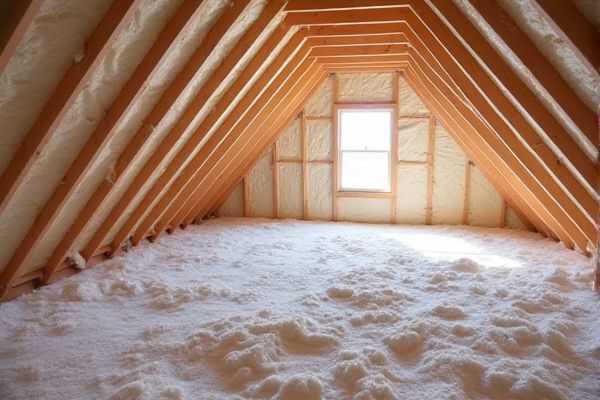
Spray foam provides superior air sealing and higher R-values per inch compared to rigid foam, making it ideal for complex attic spaces where energy efficiency and moisture control are priorities. Discover how each insulation type impacts your home's comfort and energy savings by reading the full article.
Table of Comparison
| Feature | Spray Foam Insulation | Rigid Foam Insulation |
|---|---|---|
| Material Type | Polyurethane or polyisocyanurate foam sprayed on-site | Pre-formed polystyrene, polyisocyanurate, or polyurethane panels |
| R-Value per Inch | 6 to 7 | 4 to 6.5 (varies by material) |
| Air Sealing | Excellent - seals gaps and cracks effectively | Good - requires sealing at joints and edges |
| Moisture Resistance | Closed-cell spray foam is water-resistant | Generally water-resistant, but can absorb moisture if not sealed properly |
| Installation | Professional installation required | DIY-friendly or professional installation |
| Cost | Higher initial cost | Lower initial cost |
| Durability | Long-lasting, stable over time | Durable but can be damaged if exposed |
| Environmental Impact | Contains blowing agents; options available with lower GWP | Varies by material; some options more eco-friendly |
| Best Use | Air sealing and high-performance insulation in attics | Rigid barrier insulation, supplemental use in attics |
Introduction to Attic Insulation Options
Spray foam and rigid foam are two effective attic insulation options that improve energy efficiency by minimizing heat transfer. Spray foam insulation expands to fill gaps and cracks, providing an airtight seal and superior R-value per inch, while rigid foam boards offer durable, high-density coverage with excellent moisture resistance. Your choice depends on factors like budget, ease of installation, and desired insulation performance for your attic space.
What Is Spray Foam Insulation?
Spray foam insulation is a versatile, expanding material composed of polyurethane that creates an air-tight seal in attics, effectively reducing heat loss and moisture infiltration. Unlike rigid foam, spray foam conforms to irregular spaces, providing superior insulation by filling gaps and cracks, which enhances your home's energy efficiency. Its high R-value per inch ensures maximum thermal resistance, making it an excellent choice for insulating tight areas in your attic.
What Is Rigid Foam Insulation?
Rigid foam insulation consists of high-density panels made from materials such as polyisocyanurate, extruded polystyrene (XPS), or expanded polystyrene (EPS), designed to provide excellent thermal resistance in attic spaces. It offers a continuous insulation layer that reduces heat transfer, improves energy efficiency, and controls moisture infiltration when properly installed. Rigid foam boards are durable, resistant to compression, and commonly used to insulate attic walls, roofs, and rim joists where air sealing and structural strength are important.
Installation Process: Spray Foam vs Rigid Foam
Spray foam insulation involves a chemical reaction between two liquid components that expand and cure directly on the attic surfaces, providing seamless coverage and air sealing in hard-to-reach areas. Rigid foam insulation requires precise cutting and fitting of foam boards between rafters or joists, followed by sealing the edges with tape or spray foam to minimize gaps and thermal bridging. Spray foam generally offers faster installation with superior adhesion and flexibility, while rigid foam demands more manual labor and time to achieve a tight, continuous thermal barrier.
Energy Efficiency Comparison
Spray foam insulation offers superior energy efficiency in attics by creating an airtight seal that reduces air leaks and thermal bridging, leading to enhanced temperature regulation and lower energy bills. Rigid foam boards provide good insulation value but may require additional sealing to prevent gaps that reduce overall efficiency. Choosing spray foam can significantly improve your home's energy performance due to its high R-value per inch and superior air barrier properties.
Moisture Resistance and Air Sealing
Spray foam insulation offers superior moisture resistance by creating an impermeable barrier that prevents water vapor infiltration, reducing the risk of mold and mildew in your attic. Rigid foam panels provide good moisture resistance but often require careful sealing at joints to ensure effective air sealing. Your choice impacts energy efficiency, with spray foam delivering a more comprehensive air seal compared to rigid foam insulation.
Cost Analysis: Upfront and Long-Term
Spray foam insulation typically has a higher upfront cost, averaging $1.00 to $1.50 per board foot, compared to rigid foam insulation, which ranges from $0.25 to $1.00 per square foot. Long-term savings with spray foam arise from its superior air-sealing properties and higher R-values, reducing energy bills by up to 30% annually. Rigid foam offers lower initial investment but may require additional sealing materials and maintenance, potentially increasing total lifetime costs.
Environmental Impact and Sustainability
Spray foam insulation offers superior air sealing properties that contribute to lower energy consumption, reducing your carbon footprint over time. Rigid foam boards often contain fewer harmful blowing agents and can be made from recycled materials, making them a more sustainable choice. Evaluating the environmental impact involves balancing the long-term energy savings of spray foam against the material sustainability of rigid foam, ensuring an eco-friendly attic insulation solution.
Best Applications for Each Insulation Type
Spray foam insulation excels in sealing complex attic spaces, offering superior air barrier properties and moisture resistance, making it ideal for irregularly shaped or hard-to-reach areas. Rigid foam insulation is best suited for flat attic surfaces or exterior sheathing, providing high compressive strength and consistent R-value per inch for thermal performance. Choosing between spray foam and rigid foam depends on specific attic geometry, desired air sealing, and moisture control requirements.
Choosing the Right Insulation for Your Attic
Spray foam insulation provides superior air sealing and higher R-values per inch compared to rigid foam, making it ideal for irregular attic spaces where gaps and leaks are common. Rigid foam boards offer excellent moisture resistance and ease of installation, suitable for flat surfaces and budget-conscious projects. Your choice depends on the attic's configuration, desired energy efficiency, and long-term performance goals.
 homyna.com
homyna.com